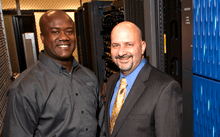President Obama has made improving STEM (Science, Technology, Engineering and Math) education in the U.S. a focal point of his administration. Behind his call to action, the President has earmarked over $400 million in his 2014 budget request to Congress to be put toward STEM programs. The President has also called on the business community to join him in promoting STEM education initiatives that will lead to more resources for teachers and more engagement among students.
Across the country, educators and the business community are responding with innovative programs to improve student performance in STEM. Specific programs are also being developed to generate more interest in STEM careers among female and minority students who are under-represented in these fields.
While careers in STEM fields offer students more job opportunities and better salaries, the number of new graduates entering STEM fields is lagging far behind the number of available and projected job opportunities in these specialties.
There has been a lot of concern that we are not getting enough students interested in going into STEM careers.
Dr. Nancy Healy
Education Director, National Nanotechnology Infrastructure Network
Customer
National Nanotechnology Infrastructure Network
Region
U.S.A.
Products & Services
Microscopy
Industry
Education
Release Date
December, 2013
Solutions By
Hitachi High Technologies America, Inc. (HHTA)
Getting students interested in the STEM fields has serious ramifications for the future and could offer young people a positive direction for future employment and career growth. But reports indicate that U.S. students continue to lag behind students from other countries in terms of their education in STEM subjects. And experts predict that the U.S. may see an employment shortage of three million workers in the STEM fields and will not have a workforce with the education or skills to fill these critical 21st century positions.
Economists estimate that job creation in the STEM fields will significantly outpace non-STEM jobs.
There is a huge gap in the need for what’s available for technical talent and what’s going to be required for technical talent in the future. That directly impacts our ability to grow our business or for the scientific community to be able to find solutions to many societal problems.
Craig Kerkove
Executive Vice President, Hitachi High Technologies America, Inc.
Schools seem to have some challenges retaining student interest in the STEM subjects. However, these fields offer the best possibilities for students to find good, well-paying jobs in the future. According to Change the Equation, in 2010, U.S. unemployment in STEM fields was much lower than total unemployment. By 2018, it is projected that the demand for people who work in the STEM fields will reach 166 million workers. At present, women and minorities are underrepresented in the STEM fields, despite the demand for qualified workers and the promise these fields offer.
I thought it was amazing. I have a couple microscopes at home that are just optical lights, mirrors. This can go to far greater levels. I was able to see things like dust particles on feathers.
Rachel Hadden
High School Student
When Hitachi miniaturized its scanning electron microscope, the company realized that its revolutionary product had novel uses it had not previously considered. The TM3000’s small size and portability meant that the microscope could travel to students, rather than having students travel to use it, eliminating geography as a barrier to using the microscope.
In discussing how the TM3000’s characteristics have made it ideal for classroom use, Hitachi High Technologies America, Inc. senior executive Bob Gordon said, "We've always had a prominent laboratory in different parts of the country and we always invited local high schools and local middle schools to come and to see what we do. But we could not move these products around freely because they take dedicated rooms or dedicated power. With the TM3000, we can put it in a car, drive it wherever we need to and wheel it in to any educational institution and it really opens up a lot of doors for us."
With the introduction of our tabletop microscope, we now have the ability to take the product anywhere throughout the U.S. market.
Bob Gordon
Senior Executive, Hitachi High Technologies America, Inc.
The addition of the www.inspireSTEMeducation.us website has added significantly to the breadth and reach of HTA’s program to advance the study of nanoscience. The website was designed to be used either with or without the ability to have the TM3000 in the classroom. The website is also free of any promotional information about HTA and was designed solely as a teaching tool for educators. All of the content is developed by educators, and HTA’s role is to simply host the site and to answer inquiries about reserving a microscope through the loan program. Realizing that teachers might feel intimidated by the subject matter or lack the time to develop new lesson plans around nanoscience, HTA has enlisted professional educators to develop learning modules and lesson plans for students of all grade levels.
The website we created is purely for educators and teachers to use.
Robert Gordon
Senior Executive, Hitachi High Technologies America, Inc.
Despite its small size, the TM3000 is a very advanced, high sophisticated piece of equipment. Indeed, to some, the microscope’s small size and usability has initially caused some customers to question the instrument’s sophistication. Any doubt in the regard, though, is quickly dispelled when people get a chance to use it.
Nancy Weaver, CEO, Left Coast Instruments, Inc. distributes the microscope for Hitachi. She says, "It is a very straight forward, very easy to use tool. It was designed as a cross-over piece between light microscopy and high end electron microscopy where a person who has little experience with an electron microscope can sit down and get up and running in about half an hour."
Robert Gordon: We want to accomplish being involved and help kids get inspired about STEM education, help teachers get more involved and utilize us as a good resource. We have uploaded thousands of images seen under the microscope onto the website, but the learning modules and content is all developed by teachers and educators for them to share and utilize among each other.
It has remarkable resolution and unbelievable flexibility.
Nancy Weaver
Left Coast Instruments, Inc.
While the microscope might look too simple to potential customers, it still seems intimidating to teachers and helping them get comfortable with it is a critical step that has to happen so they will bring it and the study of nanotechnology into the classroom. One of the ways HTA accomplishes this is to demonstrate the TM3000 at educator conferences and professional development workshops.
Hitachi High Technologies America, Inc. is clearly making an impact on improving STEM education in the U.S. with its electron microscope program. To date, more than 100 educational institutions have taken advantage of the opportunity to borrow the TM3000 microscope. Additionally, Hitachi’s educator-curated website, www.inspireSTEMeducation.us, has an active community of followers and contributors and the usage of its content is continuing to grow.
Teachers who have had the TM3000 in their classrooms and access to the www.inspireSTEMeducation.us website agree that both have been beneficial to their students. Students who have used the TM3000 in class have studied everything from forensics to analyzing the compounds in makeup. Being able to choose the samples they want to view and to run the machine themselves has been especially exciting.
Students are drawn to the microscope thanks to its ease of use. Many students are already comfortable with touch screen technology thanks to the widespread availability of tablets and smartphones. As such, it takes very little time for them to quickly and easily learn how to utilize the microscope’s touch screen features to adjust magnification levels and to manipulate their samples.
Making the microscope and this curriculum accessible to the students is really critical for us.
Dave Menshew
A high school teacher who has used Hitachi’s TM3000 to teach his students forensics
After observing teachers and students using the microscope at a summer education workshop, Tim Waters, Ed.D., President and Chief Executive Officer, Mid-continent Research for Education and Learning said, "Not only is this about advancing practitioner knowledge about NANO science and their strategies for delivering. It is also about motivating teachers to be excited about, to want to do more with STEM initiatives. The relationship with Hitachi and the other corporate sponsors of this program have brought so much to that dimension both in terms of the technical skills of teachers and the resources with which they have to work but also how it motivates teachers to want to learn more and do more and for students to be excited about being involved in STEM education. It is extraordinary, it matters and in the long run it is going to make a significant difference in the quality of STEM education."
We will never address what we need to in terms of scale and work force preparation without the active engagement and very thoughtful contributions from the business community.
Tim Waters
Ed.D., President and Chief Executive Officer, Mid-continent Research for Education and Learning
When Hitachi High Technologies America, Inc. (HTA) came out with the TM3000, its highly portable and easy to use scanning electron microscope, the company soon realized that the microscope’s small size, durability and intuitive operation made it ideally suited to classroom use. Designed mainly for use in pharmaceutical companies, medical institutions and research facilities, the microscope could be an engaging teaching tool, but one that was outside of the scope of a school system budget. But the company was committed to advance science education in the U.S. and to help teachers and students.
The company soon set aside several microscopes that it could loan out to schools, colleges, universities and summer camps, giving students and teachers the opportunity to utilize this exciting piece of advanced scientific equipment right in their classrooms.
We have been selling this product to industries, but we know that schools generally don’t have access to this type of technology. So we decided that if we could bring the microscopes to the schools, it would really benefit STEM education and we could use this to support and contribute to society.
Masahiro Miyazaki
President, Hitachi High Technologies America, Inc.
Robert Gordon concludes, “Hitachi High Technologies America would like to continue this program and we would like to see this program grow throughout the U.S. market and for us to become more aligned with other companies and with universities and national labs to continue to promote STEM education and STEM initiatives in the U.S. market.”
STEM education is critical to the future of our country. By 2018, experts predict the U.S. will have 1.2 million job openings in STEM-related occupations—but only 200,000 new graduates will have the skills to fill them. Hitachi High Technologies America, Inc. is working to inspire a new generation of achievement in STEM education by loaning its TM3000 scanning electron microscope to schools and universities around the country. In addition, a website www.inspireSTEMeducation.us was created to provide teachers who don’t have access to the microscope with lesson plans, learning modules and other teaching tools they can use to teach nanoscience in their classrooms.







